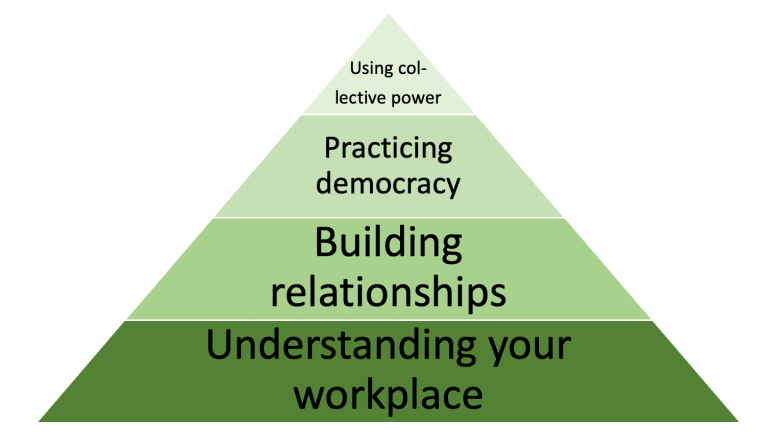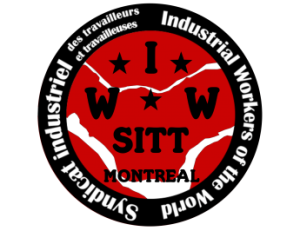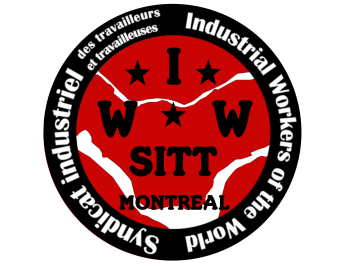The inverted pyramid
An organizer and a worker describe a direct action campaign that reaped great victories and then collapsed for lack of a solid foundation.
Anyone who has already taken the organizational training 101 You ITS-IWW (OT101) will be familiar with the organization pyramid shared below. If you've never seen it or need your memory refreshed, she goes as follows: A narrow point of “direct actions” is laid on a broader level of “democracy in the workplace” (for example, meetings), himself laid on an even broader floor of “colleague relations” (built through face-to-face discussions) ultimately resting on a foundation of “knowledge of one’s workplace” (who works there, how are the places divided, etc).

This pyramid is sometimes opposed to another going “from the bottom up” and in which a few highly motivated workers start taking direct action before (or instead) to build a solid organizational base.
There are several reasons why this other pyramid can be attractive: One is that for many workers who do not trust their persuasive skills or the ability of their colleagues to help them organize their workplace, concrete and successful direct action seems like good evidence to show their colleagues. that “collective action, it works !». Another is that building a well-established committee takes a lot of work., often boring, while the rapid recourse to direct action is exciting and sometimes leads to the gains that were the reasons for wanting to organize in the first place.
In return, an obvious reason to oppose this method is that direct action is likely to fail if there is not an organization behind to support the small group (what, after all, is the reason why it is necessary to organize at the beginning). This is a very good observation. However, there is another problem, much deeper still, which is that even if the action(s) works, without the rest of the pyramid, there is little to do to use this or these actions to create a sustainable solidarity or organization, and without them, all gains are likely to be very short-lived. Their duration will ultimately depend much more on the will of the bosses to withdraw them or not than on the strength of the organization to maintain them..
To illustrate this point, I would like to share with you an example from an organizing campaign that I supported and written by the organizer himself:
…
I inadvertently used the bottom-up pyramid model when I was a “baby organizer” working on her first campaign. I was relatively new to the IWW and although I had attended a few trainings on how to have organizing conversations and read a few books, I had not yet been able to do an organization training 101.
The company I worked for was a family business in which the different members of the family each had their own department as an independent company despite occupying the same building.. Instead of seeing this structure for what it was, i.e. an attempt to separate employees, I rather perceived my department as being the totality of the company for which I worked. So I started having one-on-one conversations with my co-workers who I felt were the most receptive and receptive to organizing our middle.. Although I had a general idea of the social cartography of my environment, I had not thoroughly analyzed the social and influence relationships before starting.
I left the seasonal aspect of the business, the fact that it closes every winter, blind my judgment and justify a fast-track approach for this organizing campaign. So I managed to get three of my six colleagues together to do a “march on the boss[1]on a few key issues including hours and wages. I didn't know the IWW taught a specific walkthrough for this tactic in OT101, but we were lucky and my boss's response didn't work. We had unknowingly proceeded relatively as the training suggested., for example by making specific requests and giving a deadline. However, during this march on the boss, one of my co-workers raised issues that I was unaware of because I had not taken the time to speak to her adequately. Alas, none of them have been solved.
Nevertheless, a few days after our march on the boss, we have been successful on several important demands: First, everyone except the foreman got a raise. Secondly, the workers had control of the schedule that they were able to do without constraint from the owner or the foreman, except for his own schedule. Thirdly, we had complained that employees were cut off before the end of their day and that they often missed hours and this practice stopped. Finally, we wanted a feedback on the previous summer's "dollar days" program that had lost us sales and we got it.
In the moment, I was in ecstasy! I proudly recounted our successes at the next meeting of the organizing committee of my local branch., then the questions began to tumble : “What exact questions did you ask your colleagues during one-on-one meetings? What did they say ?Since I hadn't bothered to take detailed notes, I was not able to give exact answers, so I couldn't bring back much of what I had learned to the rest of the group. “Did during the march on the boss you did X, Y and Z, as we were taught ?"I just didn't know we had an optimal path forward for this tactic..
As the season drew to a close, the campaign gradually dismantled. I understood that one of the three participants had sexually harassed the others throughout the summer. That the boss had installed new security cameras and that had a chilling effect on our campaign. That he told everyone working under the table that he should now declare their wages. That he himself had met single people who were then suspicious of us. He finally accused me of wanting to create a union and threatened me.
Meanwhile, realizing my mistakes, I had tried to collect contacts from people I knew and to have one-on-one meetings with employees from other departments.. Sadly, the cat was out of the bag and my colleague member of the organizing committee best placed to talk to them (because she had already worked in these departments) was now far too intimidated to take a chance.
I ended up having to move and I didn't come back for the following season. Another person I had organized could not return either due to health issues. Another came back and kept her raise but no longer wanted to organize the business. I had no other contacts to keep this campaign alive and it died.
With hindsight, I can identify the key factors that made me choose to go too fast in this campaign.
Lesson learned: No to adventurism !
I wanted to accomplish something before the season ended because I wasn't sure I wanted to come back the following year. I finally understood that it is better to organize a job in which you plan to stay for a few years because you will not be tempted to do things too quickly. We must remember that the reason for which we organize ourselves is to make our job a work environment in which we will want to stay and which we will hold on to and that, even if we can't stay there, that's not a good reason to try to go too fast. It is better to start or even complete the physical and social mapping of our workplace, to have information on the employment process and then to find someone to replace us and continue where we left off, whether it is an internal person or a “salt[2]».
I was also anxious to prove my worth to other members of the branch and I believed that deviating from the course of action was necessary because of the particularities of my work environment.. In reality, if we want to impress people in the IWW more broadly, building a sustainable and winning committee will accomplish much more than anything else, but especially, the only people we should really want to prove anything to are our co-workers. Union organizing is a risky business and our colleagues deserve an organizer who is dedicated to sticking to best practices and using methods that have proven themselves over time.. Almost everyone believes their workplace is unique, and indeed almost everyone seems to have unique conditions that justify deviating from the process., but every time someone does, the same problems occur.
I had a very adventurous vision of union action. I thought it would be great to make a march on the boss, everyone stop working, do a sit-in or whatever other action, then get earnings and honestly, it was ! But we must remember that we cannot organize ourselves alone.. We have a duty to integrate our colleagues and follow the strategy with the greatest probability of building a sustainable committee capable of improving our working conditions in the long term.. Participating in direct actions is one of the most exhilarating experiences in the world, but that's not why we do it. We do it to create a lasting counterforce on the floor. Rushing into direct action before you have created a solid foundation is not the way to go..
And yes...
What if spontaneous direct action was bound to happen, whether we participate or not ?
Sometimes, and especially in a "hot shop[3]», a group of workers may decide to confront their supervisors or stop working, slowing down or complaining about unreasonable orders from bosses in a way that affects the business. If sufficient organizational capacity has not yet been created to conduct direct action responsibly, we probably don't have enough either to stop/redirect one that could go wrong.
In such a situation, our best option is often to join the action and offer the best of our support and leadership to ensure that the action is successful while minimizing the risks to our colleagues. This kind of situation can get carried away very quickly and it is very likely that we only have time to discern who is the person with the most influence on the group and ask them a few key questions such as: “What should the boss be asked to do/change/stop ? How long do we give him to do what we ask him to do? ? Who else might want to join this action ? Are we talking to the right supervisor? ? Does he or she have the power to do what is asked of him or her? ? Who else should be part of this conversation ? What do we do if one, one or all of us are fired ? What do we do if he targets one of us as the leader? ?
Texte original: Organizing Work
Translation: Maxime K.
[1]Direct action in which a group of workers goes, without warning, meet a superior to address requests.
[2]A salt is a person who will work in a company only to organize/syndicate it.
[3]A hot-shop is a work environment in which one or more issues crying out(s) agitate the employees a lot, which often leads to spontaneous but ephemeral actions.

